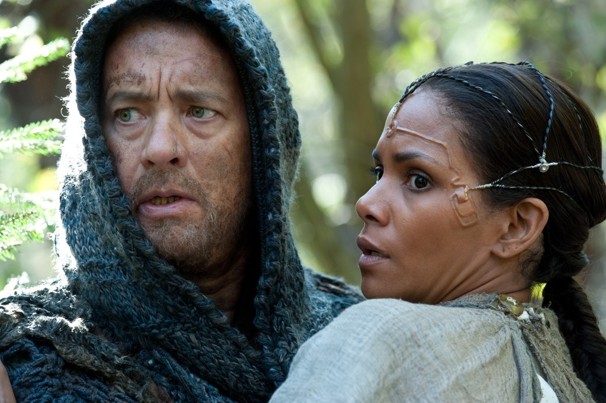‘Cloud Atlas’
January 18, 2013 Leave a comment
In the year 2012, filmmakers Andy and Lana Wachowski (“The Matrix Trilogy”) teamed up with filmmaker Tom Tykwer (“Run Lola Run,” “Perfume: The Story of a Murderer”) to adapt David Mitchell’s acclaimed novel “Cloud Atlas,” which consists of six stories set in different times (a few in different worlds), for the screen, a challenging task considering the complexity and richness of the source material.
Here is a brief breakdown of the stories:
In the year 1849, a young American lawyer named Adam Ewing (Jim Sturgess) travels by sea to the south pacific to finish singing a business contract for his father-in-law. On arrival to his destination, he witnesses the brutal whipping of a slave named Autra (David Gyasi), who plays a crucial role in Ewing’s return journey to San Fransisco.
In the year 1936, a gay English musician and composer named Robert Frobisher (Ben Wishaw) begins working for famed composer Vyvyan Ayrs (Jim Broadbent), all the while working on what will be his own masterpiece, “The Cloud Atlas Sextet,” and writing letters to his distant lover, Rufus Sixsmith (James D’Arcy).
In the year 1973, a journalist named Louisa Rey (Halle Berry) tries to uncover a nuclear conspiracy, and in the process becomes targeted by hired hitman Bill Smoke (Hugo Weaving).
In the year 2012, 65-year-old publisher Timothy Cavendish (Broadbent again) unwittingly ends up in a nursing home while on the run from some dangerous Irish gangsters.
In the year 2144, the world has undergone drastic changes and become an Orwellian dystopia. In New Seoul, Korea, a genetically engineered fabricant called Sonmi-451 (Doona Bae), before her execution, recounts her journey from being an enslaved server at a fast-food restaurant to leading a revolution against a totalitarian government.
In the year 2321, referred to as “106 winters after the fall,” all technologically advanced civilization has left earth, most others have died and the only remaining people live in a series of tribes. Some of these tribes are made up of peaceful hunter-gatherers, while others are violent barbarians. One peaceful tribesman named Zachry (Tom Hanks) experiences visions of a grotesque being he calls Old Georgie (Weaving again).
After witnessing the death of his brother-in-law at the hands of cannibalistic tribal leader (Grant again), Zachry returns home to his village where a woman named Meronym (Berry), a technologically advanced visitor, has arrived in search of an outpost station called Cloud Atlas. Meronym needs someone to guide her, and after she saves his niece from a venomous bite, Zachry agrees to lead the way.
Were the Wachowski’s and Tykwer successful in their endeavor? My answer is yes and no. Yes, because “Cloud Atlas” is a mesmerizing, beautiful film, and the work of passionate and dedicated artists who handle the material with brilliant visual style. They succeed in restructuring Mitchell’s story in order to give the six different stories — seven including a sequence by which the film is bookended — better pace and shared meaning in the moment. The special effects are tremendous but used sparingly; this is a dialogue driven film with instances of violence, suspense and humor.
But even though the film works on so many levels, where the incredibly ambitious “Cloud Atlas” occasionally stumbles is in the story department, as many of the finer details slip through the cracks, particularly in the two final segments. The filmmakers skim over a lot of concepts involving the exact hierarchy of humans in the future. There is mention of “pure bloods,” and I suppose everyone else is an “impure blood,” but I had trouble understanding who is who and why. I want to understand this more, but “Cloud Atlas” moves right along and I just ended up accepting that there are bad guys and good guys in the future, which ultimately left me feeling less attached to the 2144 segment of the film.
Some similar issues occur in the final segment, but these become a little clearer the more I think about them. They do not take away from the overall experience.
The performances in the film are consistent and entertaining, surrounded by gorgeous art direction and production design. Nearly every main actor appears in each of the segments, sometimes disguised by brilliant make-up effects to the point where I didn’t recognize otherwise very recognizable people. This is an incredible ensemble cast that works together in so many different ways that I kept sensing that “Cloud Atlas,” on top of being one of the most ambitious movies this year, could have been such a disaster under the weight of so many terrific actors in one place.
Fortunately, a disaster it is not. Tom Tykwer composed a beautiful score, and Cinematographers Frank Griebe and John Toll capture striking, memorable images that I won’t soon forget.
Aside from some story development issues, the Wachowski’s and Tykwer have done a fabulous job interconnecting the stories of “Cloud Atlas.” The directing duties were split between them. Tykwer handled the middle three segments, which I think are the best, and the Wachowski’s shot the first and final two, which are good but not great. But because they made the brave decision to intertwine the stories rather than present the movie as an omnibus of sorts, where each story is told separately, “Cloud Atlas” soars.
★★★ 1/2 (out of 4)
